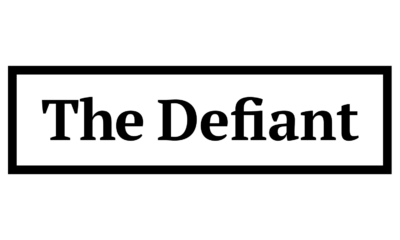News
Crypto, Venmo, NFTs, Tokens: Where Is Money Going?

When was the last time you thought about money? Sure, you pay your monthly bills—and budget and keep track of all relevant balances. But how often do users of money allow themselves to wonder about the nature of the medium of exchange the world is built around? Rachel O’Dwyer, a lecturer in digital cultures at the National College of Art and Design, in Dublin, has given the topic a lot of thought. She’s spent years talking to finance industry experts about and researching the dynamic history of financial exchange media. And she’s now condensed those insights into her new book Tokens: The Future of Money in the Age of the Platform.
The upshot: Although cash—that is, notes and coins—once upon a time revolutionized the way the world conducted business, it’s only part of the story of modern commerce. Another tectonic shift is today underway as technology changes the way transactions are carried out. So are the old, reliable paper notes, as a result, destined to become just a historical footnote? IEEE Spectrum spoke with O’Dwyer about her book and what might be in the offing as transactions go digital and money ventures out beyond the nation state.
“This is something that really fascinates me about these tokens: they’re money or money-ish, but they’re also a kind of social currency or social media.”
—Rachel O’Dwyer, National College of Art and Design, Dublin
Rachel O’Dwyer on:
IEEE Spectrum: In your most basic definition, what is a token?
Rachel O’Dwyer: Well, my definition of a token might not be everyone’s definition, but I understand a token to be something that is kind of more and less than money. So, the standard economic definition of money is something that is a means of exchange, a unit of account, and a store of value. And I feel like tokens are more, and they’re less than this. They’re less because money is designed to be fungible. It’s designed to be liquid and a means of exchange. Tokens tend to come with strings attached that place limits on their fungibility or their liquidity—special conditions about who can spend them or when or where. Amazon, for example, pays its Mechanical Turk workers outside of the United States and outside of India in gift-card balances that can be spent only by the worker and only in the Amazon store.
A token for her thoughts: Author Rachel O’Dwyer delivers new perspectives on the ancient medium of money.
This is an example of a token—an example of them being less than money. But in some ways tokens are also more, in that people will use tokens, particularly in online communities, not only to spend, but also to communicate with one another, to brag, to troll, to “flex.”
In the United States you have Venmo, an extremely popular payment program where people obviously send each other money for things like rent. But they also “flex,” showing off about what they’re spending. They troll their ex-girlfriends and use it for stalking.
Dogecoin is a speculative currency, but it was also initially a token that users used to reward each other for socially valuable content online. And this is something that really fascinates me about these tokens: They’re money or money-ish, but they’re also a kind of social currency or social media.
“The earliest forms of exchange media weren’t money as we know it; they were tokens.”
—Rachel O’Dwyer
In the book, you say tokens are like a genus, a taxonomic rank. Sort of like primates—which are, of course, an order. But following the primate analogy, money could be the homo sapiens among primates—part of the set, yet different in significant ways. If you see it differently, could you tell me how my analogy is flawed?
O’Dwyer: No, I think that’s a good analogy. Sometimes people think of tokens as a limited form of money or tokens being a subset of money. Whereas, if anything, I think of money as being a subset of tokens.
We tend to think about tokens being something that’s quite contemporary—something that reared its head with NFTs. But actually, tokens have always sort of ghosted the monetary economy and have been around before sovereign money, before publicly mandated money, before state-backed money. The earliest forms of exchange media weren’t money as we know it; they were tokens. Mesopotamian grain tokens featured the earliest forms of writing; they were these sorts of clay tokens that kept account of stored grain that was stored in these shared warehouses. And that’s not only the first examples of writing, but it’s also the first form of, I guess, accounting—and the first form of exchange media. They’re writing, they’re sort of proto-money, and they’re also tokens. People used the tokens to calculate what sort of shares you had of stored grain in these warehouses as a way of going into debt with other people.
Tokens are now smart or programmable, which is to say the conditions governing their use, redemption, and transferability are hard-coded in an object.
So, tokens have been doing the job now mainly carried out by money since long before money existed.
O’Dwyer: Exactly. Tokens have been around, as I said, for millennia. We had alms for the poor in medieval Europe. So, these were relief tokens that were given to the poor to be exchanged for things like bread and charcoal and wine. And if you had this token, it not only gave you access to these subsistence goods, it also sort of marked you out as somehow being worthy of subsistence. There’s a whole long history of these sorts of relief tokens, where charitable institutions find ways of turning cash, which was seen as being a dangerous form of relief, into some kind of a special token with strings attached. So, this was a token that came not only with value but with values or morality attached to it. In other words, How can we teach the poor about good spending habits or good morals?
“We have increasingly programmed tokens, and they are encoding particular values into spending.”
—Rachel O’Dwyer
In Ireland in the 1980s and the 1990s, alongside social-welfare payments, we had a token called the butter voucher, which allowed people who were receiving social-welfare payments to access butter. And what’s kind of interesting about the butter vouchers… When you talk to people over the age of 40 in Ireland, they’ll tell you all the things that you could access for a butter voucher besides butter. So, a shop would take them for cigarettes, for alcohol, and all sorts of things. Even though there was an attempt to encode different kinds of values and morality into food stamps or into these special tokens for the poor, often the poor and other everyday people had their own ways of getting around the terms and conditions of the tokens and making them work for themselves. And what we see today, obviously, is that a lot of the time these conditions are now hard-coded or programmed into tokens because the tokens are increasingly digital. In the United States, for example, instead of food stamps, you now have the EBT card. It’s an electronic card that basically just prevents people from buying things that aren’t sanctioned by the U.S. authorities for purchase through the food-stamp program. So, you can’t buy hot deli meals, for example. You can only buy cold food. You can’t buy hygiene products. You can’t buy cigarettes or alcohol.
And there is really no wiggle room in these new kinds of tokens. So, we have increasingly programmed tokens, and they are encoding particular values into spending. So, it’s an economic model that’s not just about who has access to credit or finance or money. It’s also encoding values at the point of transaction and the point of spending.
“We’ll probably continue to see platforms take money in more unexpected directions.”
—Rachel O’Dwyer
You wrote that private money is inevitable, and the state’s role in money issuance will be absorbed by platforms with a legacy in processing data and programming behavior. So what do you see as the consequences of private entities such as Facebook being more and more in control of identity and commerce at that level?
O’Dwyer: I’m surprised if I said that it was inevitable, because I think what was very interesting about Facebook’s attempt to issue its own currency was the pushback by the state against private currency. When Facebook announced that it was going to issue its own token in 2019, I think a lot of people thought that battle was then fought and won—that we were witnessing a battle for control of money and payments between the state and the platform, and the state prevailed. And at the moment that Facebook and other big platforms were poised to take control of currency issuance, stronger regulation and the development of proposals for state-backed digital currencies, or CBDCs, worked to suppress the expectation that platforms will issue and guarantee money in the future.
But I think where the balance falls is still very much unclear. In China, for example, Alipay and WeChat Pay, which are two incredibly powerful and popular payment apps, have experienced very strong regulation by the Chinese government in recent years— particularly because they were seen to compete with the government’s launch of a digital yuan.
And yet, most people continue to—and actually prefer—to use these applications rather than the state pilot. What’s more, even though we’ve seen strong regulation of payment and crypto in recent months, particularly in the United States, we’ll probably continue to see platforms take money in more unexpected directions.
In reading your account of what happened with Facebook’s fizzled Diem token, I don’t see the U.S. government having erected a brick wall. How likely is it that its moves amounted to spraying cold water on Facebook and the social media giant will come back later?
O’Dwyer: I guess what’s interesting is this isn’t Facebook’s first attempt to to issue money. They’ve had numerous failed currencies and wallets in their 15-year history, and Libra is just one of those. But there have been concerted attempts over the past five or six years by big platforms in the West to develop a super app similar to the Chinese model of WeChat or Alipay. And I suppose Elon Musk’s claim that X will become a banking platform is maybe the latest one of those. But for now, governments have pushed forward to erect barriers against this. One example is the U.S.’s 2020 Keep Big Tech Out of Finance Act.
But, as you say, it’s all still very much up in the air.
You note that despite all the hyped promises of cryptocurrencies and the blockchain, what they’ve really done so far is just change the middlemen. Can the average consumer count on the blockchain to keep tyranny from riding in on the coattails of so-called progress?
O’Dwyer: Absolutely not.
“[Web3 is] not about actually removing power or creating new forms of trust. If anything, it’s allowing a lot of malfeasance and problematic, scammy behavior to operate in this sort of murky space.”
—Rachel O’Dwyer
What we’re seeing right now with FTX and the conviction of Sam Bankman-Fried is a case in point where some of the claims that were being made around crypto are being disproven—particularly, that if you had lost your trust in centralized banking or in centralized institutions, crypto and the sort of radical decentralization of finance was supposed to offer you a sort of trustless alternative.
What we’ve seen is that, actually, these private institutions are a lot less accountable, a lot more scammy, and a lot less trustworthy. And in recent years, we’ve heard a lot about Web3. There are claims that it’s going to shake up the power of platforms and decentralize the Internet. Similar claims were made with the advent of Bitcoin with respect to banks and the state.
One of the things I find most fascinating about the history of alternative tokens and alternative economies is that this idea of decentering power and removing the middleman crops up time and again. Pierre-Joseph Proudhon, [the 19th-century French philosopher and economist] sometimes referred to as the father of anarchism, designed tokens to do away with what he called the ‘parasitic middlemen’ in the 1800s. So, too, did key figures in the development of alternative economies, like Silvio Gesell and Josiah Warren. They wanted to create tokens that would remove unnecessary power and privilege. So, what’s striking is that while these men, on the one hand, preached the end of power, they allowed all kinds of power and privilege to flow unchecked. And I think the same can be said for the politics of Web3 today. They preach decentralization, but in a lot of cases there’s just a replacement of incumbent payment processors or incumbent banks with new fintech players. It’s not about actually removing power or creating new forms of trust. If anything, it’s allowing a lot of malfeasance and problematic, scammy behavior to operate in this sort of murky space.
“I think that any of the [blockchain] iterations we’re seeing—including smart contracts and smart payments—look a lot more like TheHandmaid’s Tale than any resistance to the situation depicted in the book.”
—Rachel O’Dwyer
In the book, you refer to a scene in the The Handmaid’s Tale where a woman found herself unable to make purchases using a smart token that had been programmed to deny the transfer of funds based on gender. What role do you think blockchains will play in preventing such dystopian outcomes from becoming reality? And, considering what you just said, I’m assuming your answer will be nothing.
O’Dwyer: Yeah, I haven’t really considered blockchain as being a way of preventing that.
When I was thinking of TheHandmaid’s Tale, I suppose I was seeking a good illustration of what happens when tokens become programmable either at the behest of the state or the platform. So, that way, tokens can then be used to survey or profile users or condition their behaviors. For me, that example in TheHandmaid’s Tale is a perfect illustration of that.
But I guess proponents of the blockchain would say, when payments become decentralized, then nobody can control what you do.
But we know that with any actual iteration of these, there is always permission. They’re always controlled. So, if anything, I think that any of the [blockchain] iterations we’re seeing—including smart contracts and smart payments—look a lot more like TheHandmaid’s Tale than any resistance to the situation depicted in the book.
Okay, so let’s spin things forward. There are already Amazon Go retail outlets, in which there’s no checkout as we’ve come to know it. Biometric identification linked to an agreed-upon form of payment handles the transaction seamlessly for the items you carry out. So, my question to you is: Thirty years from now, what will grocery shopping look like? Do you think we’ll see widespread adoption of the Amazon Go model? Or will retail shops go away entirely?
When I was at [the global fintech conference] Money 20/20 a couple of years ago, they spoke a lot about this idea of frictionless payment. Payment would become so ambient that it would sort of disappear into the background. You wouldn’t even be aware that you’d made a transaction. And it comes being presented as being something a little bit more convenient. You don’t ever have to worry about fumbling for your notes or your change at the checkout [or when you stop to refuel your car,] so your car would automatically pay for gas. Your pool would automatically order filters. And maybe you would go into an Amazon Go and just grab the things you need, and your transactional data would also then potentially update supply chains and make them run better. That means the groceries and things that you want are more likely to be available for you, and you’d automatically get coupons more suited to you, et cetera, et cetera.
“It’s often framed as being something we gain—as in we’re gaining kind of a lack of friction…. But look at what we’re losing. We’re losing the right not to be tracked, losing the right not to be identified.”
—Rachel O’Dwyer
I’m forgetting an important layer of this—that Internet of Things and generative AI could one day intervene, so that your refrigerator and your cupboards will talk to your local grocer and say, “Listen, he’s running out of X and Y. Send us some more X and Y to this address today.”
O’Dywer: This bit about the Internet of Things brings to mind Mark Weiser and the early ambient-computing imaginaries from the turn of the 21st century. Weiser was one of the earliest proponents of ubiquitous computing, and he wrote these papers like “The Computer for the 21st Century.” He had this idea that computing should disappear into the background; you shouldn’t be aware of it.
But should transactions be something that disappears into the background, so you shouldn’t really be aware of it? It seemed like a very privileged frame in one way. And then, I suppose, the second thing that worries me about it is the idea that cash, an anonymous bearer instrument, completely disappears from this model.
It’s often framed as being something we gain—as in we’re gaining kind of a lack of friction because we don’t have to, like, wait around, we don’t fumble with our change. But look at what we’re losing. We’re losing the right not to be tracked, losing the right not to be identified.
And poor people and elderly people who still rely on cash are increasingly being discriminated against by these sorts of cashless systems. Even as governments are paying lip service to financial inclusion or banking beyond banks or bringing the elderly into the digital fold, they talk about the vision of the cashless society. But all of these things, I think, are worrying. I think we have a right to cash. We have a right to this anonymous instrument for exchanges, and we lose all of that when we move to these fully automated systems.
But do I think that is the future of digital payments? Yeah, probably.
From Your Site Articles
Related Articles Around the Web
News
Bitcoin soars above $63,000 as money flows into new US investment products

Bitcoin has surpassed the $63,000 mark for the first time since November 2021. (Chesnot via Getty Images)
Bitcoin has broken above the $63,000 (£49,745) mark for the first time since November 2021, when the digital asset hit its all-time high of over $68,000.
Over the past 24 hours, the value of the largest digital asset by market capitalization has increased by more than 8% to trade at $63,108, at the time of writing.
Learn more: Live Cryptocurrency Prices
The price appreciation was fueled by record inflows into several U.S.-based bitcoin cash exchange-traded funds (ETFs), which were approved in January this year.
A Bitcoin spot ETF is a financial product that investors believe will pave the way for an influx of traditional capital into the cryptocurrency market. Currently, indications are favorable, with fund managers such as BlackRock (BLK) and Franklin Templeton (BEN), after allocating a record $673 million into spot Bitcoin ETFs on Wednesday.
Learn more: Bitcoin’s Success With SEC Fuels Expectations for an Ether Spot ETF
The record allocation surpassed the funds’ first day of launch, when inflows totaled $655 million. BlackRock’s iShares Bitcoin Trust ETF (I BITE) alone attracted a record $612 million yesterday.
Bitcoin Price Prediction
Earlier this week, veteran investor Peter Brandt said that bitcoin could peak at $200,000 by September 2025. “With the push above the upper boundary of the 15-month channel, the target for the current market bull cycle, which is expected to end in August/September 2025, is raised from $120,000 to $200,000,” Brandt said. published on X.
The influx of capital from the traditional financial sphere into Bitcoin spot ETFs is acting as a major price catalyst for the digital asset, but it is not the only one. The consensus among analysts is that the upcoming “bitcoin halving” could continue to drive flows into the bitcoin market.
The Bitcoin halving is an event that occurs roughly every four years and is expected to happen again next April. The halving will reduce the bitcoin reward that miners receive for validating blocks on the blockchain from 6.25 BTC to 3.125 BTC. This could lead to a supply crunch for the digital asset, which could lead to price appreciation.
The story continues
Watch: Bitcoin ETFs set to attract funds from US pension plans, says Standard Chartered analyst | Future Focus
Download the Yahoo Finance app, available for Apple And Android.
News
FRA Strengthens Cryptocurrency Practice with New Director Thomas Hyun

Forensic Risk Alliance (FRA), an independent consultancy specializing in regulatory investigations, compliance and litigation, has welcomed U.S.-based cryptocurrency specialist Thomas Hyun as a director of the firm’s global cryptocurrency investigations and compliance practice. Hyun brings to the firm years of experience building and leading anti-money laundering (AML) compliance programs, including emerging payment technologies in the blockchain and digital asset ecosystem.
Hyun has nearly 15 years of experience as a compliance officer. Prior to joining FRA, he served as Director of AML and Blockchain Strategy at PayPal for four years. He established PayPal’s financial crime policy and control framework for its cryptocurrency-related products, including PayPal’s first consumer-facing cryptocurrency offering on PayPal and Venmo, as well as PayPal’s branded stablecoin.
At PayPal, Hyun oversaw the second-line AML program for the cryptocurrency business. His responsibilities included drafting financial crime policies supporting the cryptocurrency business, establishing governance and escalation processes for high-risk partners, providing credible challenge and oversight of front-line program areas, and reporting to the Board and associated authorized committees on program performance.
Prior to joining PayPal, Hyun served as Chief Compliance Officer and Bank Secrecy Officer (BSA) at Paxos, a global blockchain infrastructure company. At Paxos, he was responsible for implementing the compliance program, including anti-money laundering and sanctions, around the company’s digital asset exchange and its asset-backed tokens and stablecoins. He also supported the company’s regulatory engagement efforts, securing regulatory approvals, supporting regulatory reviews, and ensuring compliance with relevant digital asset requirements and guidelines.
Thomas brings additional experience in payments and financial crime compliance (FCC), having previously served as Vice President of Compliance at Mastercard, where he was responsible for compliance for its consumer products portfolio. He also spent more than seven years in EY’s forensics practice, working on various FCC investigations for U.S. and foreign financial institutions.
Hyun is a Certified Anti-Money Laundering Specialist (CAMS) and a Certified Fraud Examiner (CFE). He is a graduate of New York University’s Stern School of Business, where he earned a bachelor’s degree in finance and accounting. Additionally, he serves on the board of directors for the Central Ohio Association of Certified Anti-Money Laundering Specialists (ACAMS) chapter.
Commenting on his appointment, Hyun said, “With my experience overseeing and implementing effective compliance programs at various levels of maturity and growth, whether in a startup environment or large enterprises, I am excited to help our clients overcome similar obstacles and challenges to improve their financial crime compliance programs. I am excited to join FRA and leverage my experience to help clients navigate the complexities of AML compliance and financial crime prevention in this dynamic space.”
FRA Partner, Roy Pollittadded: “As the FRA’s sponsor partner for our growing Cryptocurrency Investigations and Compliance practice, I am thrilled to have Thomas join our ever-expanding team. The rapid evolution of blockchain and digital asset technologies presents both exciting opportunities and significant compliance challenges. Hiring Thomas in a leadership role underscores our commitment to staying at the forefront of the industry by enhancing our expertise in anti-money laundering and blockchain strategy.”
“Thomas’ extensive background in financial crime compliance and proven track record of building risk-based FCC programs in the blockchain and digital asset space will be invaluable as we continue to provide our clients with the highest level of service and innovative solutions.”
“FRA strengthens cryptocurrency practice with new director Thomas Hyun” was originally created and published by International Accounting Bulletina brand owned by GlobalData.
The information on this website has been included in good faith for general information purposes only. It is not intended to amount to advice on which you should rely, and we make no representations, warranties or assurances, express or implied, as to its accuracy or completeness. You must obtain professional or specialist advice before taking, or refraining from, any action on the basis of the content on our website.
News
Bitcoin trades around $57,000, crypto market drops 6% ahead of Fed decision

-
Bitcoin fell in line with the broader cryptocurrency market, with ether and other altcoins also falling.
-
Financial markets were weighed down by risk-off sentiment ahead of the Fed’s interest rate decision and press conference later in the day.
-
10x Research said it is targeting a price target of $52,000 to $55,000, anticipating further selling pressure.
Bitcoin {{BTC}} was trading around $57,700 during European morning trading on Wednesday after falling to its lowest level since late February, as the world’s largest cryptocurrency recorded its worst month since November 2022.
BTC has fallen about 6.3% over the past 24 hours, after breaking below the $60,000 support level late Tuesday, according to data from CoinDesk. The broader crypto market, as measured by the CoinDesk 20 Index (CD20), lost nearly 9% before recovering part of its decline.
Cryptocurrencies have been hurt by risk-off sentiment in broader financial markets amid stagflation in the United States, following indications of slowing growth and persistent inflation that have dampened hopes of an interest rate cut by the Federal Reserve. The Federal Open Market Committee is due to deliver its latest rate decision later in the day.
Ether {{ETH}} fell about 5%, dropping below $3,000, while dogecoin {{DOGE}} led the decline among other major altcoins with a 9% drop. Solana {{SOL}} and Avalanche {{AVAX}} both lost about 6%.
Bitcoin plunged in April, posting its first monthly loss since August. The 16% drop is the worst since November 2022, when cryptocurrency exchange FTX imploded, but some analysts are warning of further declines in the immediate future.
10x Research, a digital asset research firm, said it sees selling pressure toward the $52,000 level due to outflows from U.S. cash exchange-traded funds, which have totaled $540 million since the Bitcoin halving on April 20. It estimates that the average entry price for U.S. Bitcoin ETF holders is $57,300, so this could prove to be a key support level.
The closer the bitcoin spot price is to this average entry price, the greater the likelihood of a new ETF unwind, 10x CEO Markus Thielen wrote Wednesday.
“There may have been a lot of ‘TradeFi’ tourists in crypto – pushing longs all the way to the halving – that period is now over,” he wrote. “We expect more unwinding as the average Bitcoin ETF buyer will be underwater when Bitcoin trades below $57,300. This will likely push prices down to our target levels and cause a -25% to -29% correction from the $73,000 high – hence our $52,000/$55,000 price target over the past three weeks.”
The story continues
UPDATE (May 1, 8:56 UTC): Price updates throughout the process.
UPDATE (May 1, 9:57 UTC): Price updates throughout the process.
UPDATE (May 1, 11:05 UTC): Adds analysis from 10x.
News
The Cryptocurrency Industry Is Getting Back on Its Feet, for Better or Worse

Hello from Austin, where thousands of crypto enthusiasts braved storms and scorching heat to attend Consensus. The industry’s largest and longest-running conference, which can sometimes feel like a religious revival, offers opportunities to chat and listen to leading names in crypto. And for the casual observer, Consensus offers a useful glimpse into the mood of an industry prone to wild swings in fortune.
Unsurprisingly, the mood is noticeably more positive than it was a year ago, when crowds were sparse and many attendees were quietly confiding that they were considering switching to AI. In practice, that means some of the more obnoxious elements are back, but not to the level of Consensus 2018 in New York, when charlatans parked Lamborghinis outside the event and the hallways were lined with booth girls and scammers pitching “ICOs in a box.”
This time around, Elon Musk’s Cybertrucks have replaced Lamborghinis as the vehicle of choice for marketers. One of the most notable publicity stunts was a startup that paid a poor guy to parade around in the Texas sun in a Jamie Dimon costume, wig, and mask, and then staged a mock assault on him by memecoin characters.
Outside the event was a giant “RFK for President” truck, while campaign staffers manned a booth instead — a reflection of both the election year and crypto’s willingness to latch onto any candidate, no matter how outlandish, who will talk about the industry. RFK himself is scheduled to address the conference on Thursday.
Excesses aside, the general sense of optimism was understandable. The cryptocurrency market has not only recovered from the wave of fraud that nearly sank it in 2022, it is riding a new wave of political legitimacy. This month, cryptocurrencies scored once-unthinkable political victories in Washington, D.C., and there is a sense that the industry has not only withstood the relentless regulatory assaults of SEC Chairman Gary Gensler and Sen. Elizabeth Warren, but is poised to defeat them.
And while cryptocurrency is still searching for its flagship application, the optimists I spoke with pointed to signs that it is (once again) upon us. Those signs include the rapid advancement of zero-knowledge proofs as well as the popularity of Coinbase’s Base blockchain and, perhaps most importantly, the large-scale arrival of traditional finance into the world of cryptocurrencies – a development that not only provides a major financial boost, but also a new element of stability and maturity that will, perhaps, tame the worst of crypto’s wilder side. Finally, this consensus marked the end of the Austin era as the conference, under new leadership, will be held in Toronto and Hong Kong in 2025.
The story continues
Jeff John Roberts
jeff.roberts@fortune.com
@jeffjohnroberts
This story was originally featured on Fortune.com
-

 News1 year ago
News1 year agoBitcoin soars above $63,000 as money flows into new US investment products
-

 DeFi1 year ago
DeFi1 year agoEthena downplays danger of letting traders use USDe to back risky bets – DL News
-

 News1 year ago
News1 year agoFRA Strengthens Cryptocurrency Practice with New Director Thomas Hyun
-

 DeFi1 year ago
DeFi1 year agoZodialtd.com to revolutionize derivatives trading with WEB3 technology
-

 Markets1 year ago
Markets1 year agoBitcoin Fails to Recover from Dovish FOMC Meeting: Why?
-

 DeFi1 year ago
DeFi1 year ago👀 Lido prepares its response to the recovery boom
-

 Markets1 year ago
Markets1 year agoWhale Investments in Bitcoin Reached $100 Billion in 2024, Fueling Crazy Investor Optimism ⋆ ZyCrypto
-

 Markets1 year ago
Markets1 year agoWhy Bitcoin’s price of $100,000 could be closer than ever ⋆ ZyCrypto
-

 DeFi1 year ago
DeFi1 year agoPancakeSwap integrates Zyfi for transparent, gas-free DeFi
-

 Markets1 year ago
Markets1 year agoWhales are targeting these altcoins to make major gains during the bull market 🐋💸
-

 DeFi1 year ago
DeFi1 year ago🏴☠️ Pump.Fun operated by Insider Exploit
-

 News1 year ago
News1 year agoHow to make $1 million with crypto in just 1 year 💸📈





